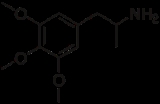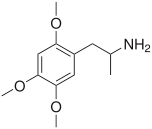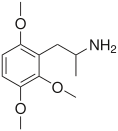
Trimethoxyamphetamine
Encyclopedia
TMAs, also known as trimethoxyamphetamines, are a family of isomer
ic psychedelic
hallucinogenic drugs
. There exist six different TMAs that differ only in the position of the three methoxy
groups
: TMA, TMA-2, TMA-3, TMA-4, TMA-5, and TMA-6. The TMAs are analogs of the phenethylamine
cactus
alkaloid
mescaline
. The TMAs are substituted amphetamine
s, however, their action does not resemble that of the unsubstituted compound amphetamine, which is a stimulant
and not a psychedelic. It is reported that some TMA's elicit a range of emotions ranging from sadness to empathy and euphoria. Several TMAs were first synthesized
by the chemist Alexander Shulgin
. Synthesis data as well as human
activity data has been published in the book PiHKAL (Phenethylamines i Have Known And Loved)
.
The most important TMA compound from a pharmacological standpoint is TMA-2, as this isomer has been much more widely used as a recreational drug and sold on the black market and as a "research chemical"; TMA (sometimes referred to as "mescalamphetamine") and TMA-6 have also been used in this way to a lesser extent. These three isomers are significantly more active as hallucinogenic drugs, and have consequently been placed onto the illegal drug schedules in some countries such as the Netherlands
and Japan
. The other three isomers TMA-3, TMA-4 and TMA-5 are not known to have been used as recreational drugs to any great extent, and remain obscure scientific curiosities.
, C12H19NO3, and the same molecular mass
, 225.28 g/mol.
Isomer
In chemistry, isomers are compounds with the same molecular formula but different structural formulas. Isomers do not necessarily share similar properties, unless they also have the same functional groups. There are many different classes of isomers, like stereoisomers, enantiomers, geometrical...
ic psychedelic
Psychedelic
The term psychedelic is derived from the Greek words ψυχή and δηλοῦν , translating to "soul-manifesting". A psychedelic experience is characterized by the striking perception of aspects of one's mind previously unknown, or by the creative exuberance of the mind liberated from its ostensibly...
hallucinogenic drugs
Psychoactive drug
A psychoactive drug, psychopharmaceutical, or psychotropic is a chemical substance that crosses the blood–brain barrier and acts primarily upon the central nervous system where it affects brain function, resulting in changes in perception, mood, consciousness, cognition, and behavior...
. There exist six different TMAs that differ only in the position of the three methoxy
Methoxy
In chemistry , methoxy refers to the functional group consisting of a methyl group bound to oxygen. This alkoxy group has the formula O–CH3.The word is used in organic nomenclature usually to describe an ether...
groups
Functional group
In organic chemistry, functional groups are specific groups of atoms within molecules that are responsible for the characteristic chemical reactions of those molecules. The same functional group will undergo the same or similar chemical reaction regardless of the size of the molecule it is a part of...
: TMA, TMA-2, TMA-3, TMA-4, TMA-5, and TMA-6. The TMAs are analogs of the phenethylamine
Phenethylamine
Phenylethylamine or phenethylamine is a natural monoamine alkaloid, trace amine, and also the name of a class of chemicals with many members well known for psychoactive drug and stimulant effects. Studies suggest that phenylethylamine functions as a neuromodulator or neurotransmitter in the...
cactus
Cactus
A cactus is a member of the plant family Cactaceae. Their distinctive appearance is a result of adaptations to conserve water in dry and/or hot environments. In most species, the stem has evolved to become photosynthetic and succulent, while the leaves have evolved into spines...
alkaloid
Alkaloid
Alkaloids are a group of naturally occurring chemical compounds that contain mostly basic nitrogen atoms. This group also includes some related compounds with neutral and even weakly acidic properties. Also some synthetic compounds of similar structure are attributed to alkaloids...
mescaline
Mescaline
Mescaline or 3,4,5-trimethoxyphenethylamine is a naturally occurring psychedelic alkaloid of the phenethylamine class used mainly as an entheogen....
. The TMAs are substituted amphetamine
Substituted amphetamine
Substituted amphetamines are a chemical class of stimulants, entactogens, hallucinogens, and other drugs. They feature a phenethylamine core with a methyl group attached to the alpha carbon resulting in amphetamine, along with additional substitutions...
s, however, their action does not resemble that of the unsubstituted compound amphetamine, which is a stimulant
Stimulant
Stimulants are psychoactive drugs which induce temporary improvements in either mental or physical function or both. Examples of these kinds of effects may include enhanced alertness, wakefulness, and locomotion, among others...
and not a psychedelic. It is reported that some TMA's elicit a range of emotions ranging from sadness to empathy and euphoria. Several TMAs were first synthesized
Chemical synthesis
In chemistry, chemical synthesis is purposeful execution of chemical reactions to get a product, or several products. This happens by physical and chemical manipulations usually involving one or more reactions...
by the chemist Alexander Shulgin
Alexander Shulgin
Alexander "Sasha" Theodore Shulgin is an American pharmacologist, chemist, artist, and drug developer.Shulgin is credited with the popularization of MDMA, commonly known as ecstasy, in the late 1970s and early 1980s, especially for psychopharmaceutical use and the treatment of depression and...
. Synthesis data as well as human
Human
Humans are the only living species in the Homo genus...
activity data has been published in the book PiHKAL (Phenethylamines i Have Known And Loved)
PiHKAL
PiHKAL: A Chemical Love Story is a book by Dr. Alexander Shulgin and Ann Shulgin which was published in 1991. The subject of the work is psychoactive phenethylamine chemical derivatives, notably those that act as psychedelics and/or empathogen-entactogens...
.
The most important TMA compound from a pharmacological standpoint is TMA-2, as this isomer has been much more widely used as a recreational drug and sold on the black market and as a "research chemical"; TMA (sometimes referred to as "mescalamphetamine") and TMA-6 have also been used in this way to a lesser extent. These three isomers are significantly more active as hallucinogenic drugs, and have consequently been placed onto the illegal drug schedules in some countries such as the Netherlands
Netherlands
The Netherlands is a constituent country of the Kingdom of the Netherlands, located mainly in North-West Europe and with several islands in the Caribbean. Mainland Netherlands borders the North Sea to the north and west, Belgium to the south, and Germany to the east, and shares maritime borders...
and Japan
Japan
Japan is an island nation in East Asia. Located in the Pacific Ocean, it lies to the east of the Sea of Japan, China, North Korea, South Korea and Russia, stretching from the Sea of Okhotsk in the north to the East China Sea and Taiwan in the south...
. The other three isomers TMA-3, TMA-4 and TMA-5 are not known to have been used as recreational drugs to any great extent, and remain obscure scientific curiosities.
TMAs
|
|
| ||||||||||||||||||||||||||||||
|
|
| ||||||||||||||||||||||||||||||
Chemical data
As they are isomers the TMAs have the same totals formulaChemical formula
A chemical formula or molecular formula is a way of expressing information about the atoms that constitute a particular chemical compound....
, C12H19NO3, and the same molecular mass
Molecular mass
The molecular mass of a substance is the mass of one molecule of that substance, in unified atomic mass unit u...
, 225.28 g/mol.
Properties
| Compound | Pattern | Dose | Duration |
|---|---|---|---|
| TMA | 3,4,5 | 100 – 250 mg | 6 - 8 h |
| TMA-2 | 2,4,5 | 20 – 40 mg | 8 - 12 h |
| TMA-3 | 2,3,4 | > 100 mg | unknown |
| TMA-4 | 2,3,5 | 80 mg | ~ 6 h |
| TMA-5 | 2,3,6 | ≥ 30 mg | 8 - 10 h |
| TMA-6 | 2,4,6 | 25 – 50 mg | 12 - 16 h |
See also
- PsychedelicPsychedelicThe term psychedelic is derived from the Greek words ψυχή and δηλοῦν , translating to "soul-manifesting". A psychedelic experience is characterized by the striking perception of aspects of one's mind previously unknown, or by the creative exuberance of the mind liberated from its ostensibly...
- Hallucinogenic drug
- PhenethylaminePhenethylaminePhenylethylamine or phenethylamine is a natural monoamine alkaloid, trace amine, and also the name of a class of chemicals with many members well known for psychoactive drug and stimulant effects. Studies suggest that phenylethylamine functions as a neuromodulator or neurotransmitter in the...
s - AmphetamineAmphetamineAmphetamine or amfetamine is a psychostimulant drug of the phenethylamine class which produces increased wakefulness and focus in association with decreased fatigue and appetite.Brand names of medications that contain, or metabolize into, amphetamine include Adderall, Dexedrine, Dextrostat,...
s - Recreational drug useRecreational drug useRecreational drug use is the use of a drug, usually psychoactive, with the intention of creating or enhancing recreational experience. Such use is controversial, however, often being considered to be also drug abuse, and it is often illegal...
- 2,5-Dimethoxy-4-Substituted Amphetamines






